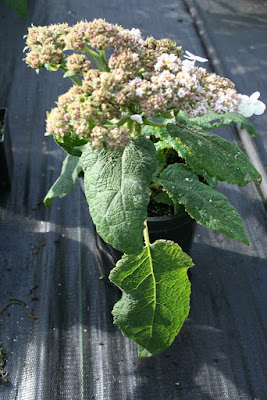Hydrangea sargentiana is native to western China. It grow in dense forests in valleys or on mountain slopes at elevations of 700-1800 meters above sea level.
Hydrangea sargentiana also called as Velvet-leaved hydrangea, Sargent Hydrangea, Hydrangea aspera subsp. sargentiana, is a species of the genus Hydrangea. This species was described by Alfred Rehder in 1911.
IDENTIFY HYDRANGEA SARGENTIANA PLANT
Hydrangea sargentiana is native to western China. It grow in dense forests in valleys or on mountain slopes at elevations of 700-1800 meters above sea level.
It is an upright, rounded, deciduous shrub which reaching 2-3 meters tall with thick branchlets and thick, 3-9 cm petiole. The leaves are abaxially gray-green to slightly purple when fresh, adaxially dark green, elliptic, oblong-ovate, or broadly ovate, 9-30 × 6-16 cm, submembranous to thinly papery, abaxially densely slightly curved villous, adaxially densely translucent strigose, secondary veins 8-11 on both sides of midvein, abaxially prominent, base rounded to shallowly cordate, margin irregularly triangular dentate to denticulate, apex acuminate.
Velvet-leaved hydrangea bloom in July from the corymbose cymes inflorescences which are 10-16 cm wide, apex arcuate; branches numerous, crowded together at apex of peduncle. The sterile flowers with sepals 4, white, obovate-orbicular to broadly orbicular, 0.9-1.4 × 0.8-1.7 cm in fruit, margin entire. The fertile flowers with calyx tube campanulate, ca. 1 mm; teeth triangular, ca. 0.5 mm. The petals are purplish blue, ovate, ca. 2 mm.
The key to identify this species is: ovary completely inferior; capsule apex truncate; petals free; seeds winged at both ends; leaf blade margin serrate, ovate, oblong-ovate, or elliptic, submembranous or thinly papery; bracts not enveloping inflorescence in bud, lanceolate; shrubs or small trees; branchlets, petiole, and peduncle with translucent hairs.
HYDRANGEA SARGENTIANA PLANT CARE AND CULTURE
Cultural information should only be used as a guide, and should be to be adapted to suit you. Your physical location; where you grow your plants, how much time you have to devote to their care, and many other factors, will need to be taken into account. Only then can you decide on the cultural methods that best suit you and your plants.
Light:
Hydrangea sargentiana love the warm morning sun, but they dislike the heat of the afternoon (can grow in full sun with adequate soil moisture). The best place to plant this species is in a sheltered location with sunny mornings and shady afternoons. Avoid planting directly underneath trees, which can lead to competition for water and nutrients. Although they can be successfully grown in full shade, they will not bloom well.
Temperature:
Keep the plants in a cool location, from 18° to 24°C. This plant grow well and are reliably winter hardy. Cold winters and late spring frosts can often kill flower buds, preventing plants from blooming in the spring.
Substrate, growing media:
Hydrangea sargentiana are best planted in soil that has been amended with adequate amounts of organic matter, such as compost, leaf mold, or well-composted manure. Soil pH generally affects the flower color for this shrub, namely, blue in highly acidic soils (pH below 5.5) and pink to purple pink in alkaline soils (pH above 7.0). Add aluminum sulfate to the soil to make the flowers bluer or add lime to the soil to make the flowers pinker.
Watering and humidity:
Velvet-leaved hydrangea prefer consistent moisture but dislike wet feet. Mulch to help conserve moisture and cool the root system. A two- to three-inch layer of mulch will help to conserve moisture.
Fertilizer:
Fertilizing is generally not recommended unless a nutrient deficiency is observed. This plants may need little fertilizer in rich soil with organic matter applied yearly. Avoid using too much nitrogen - this can encourage foliage growth at the expense of blooms.
Pruning:
Hydrangea sargentiana should only be pruned immediately after they bloom and pruning should be kept to a minimum. If this plant is pruned in the fall or winter, it will not bloom in the spring or summer, and will flower in the following growing season. Dead or diseased branches can be pruned out at any time of the year.















COMMENTS